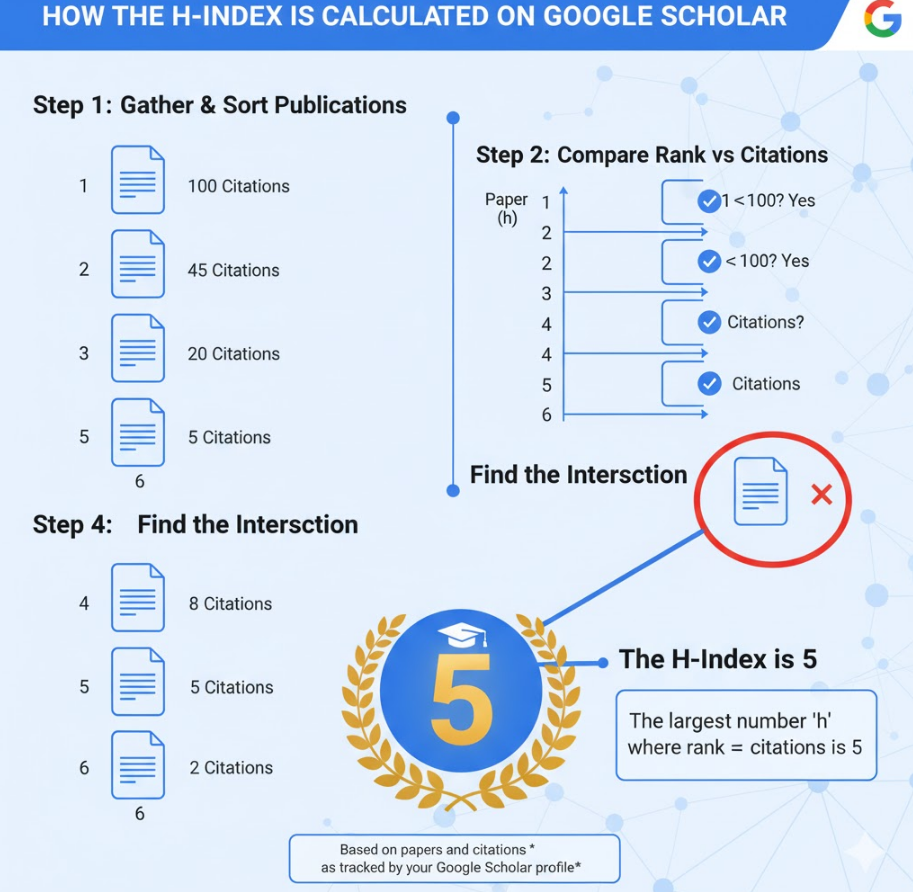

261 views||Release time: Oct 21, 2025
The h-index is a key metric displayed prominently on Google Scholar author profiles, providing a quick snapshot of a researcher's cumulative impact. Proposed by physicist Jorge E. Hirsch in 2005, it aims to measure both the quantity (number of papers) and quality (number of citations) of a scholar's output in a single number.
But how does Google Scholar actually arrive at this number? The calculation is straightforward and follows Hirsch's original definition, but its accuracy depends entirely on the data within Google Scholar's index and the author's profile.

A scholar has an h-index of 'h' if:
'h' of their total 'N' publications have at least 'h' citations each.
The remaining (N - h) publications have no more than 'h' citations each.
In simpler terms, it finds the largest number 'h' such that an author has published 'h' papers that have each been cited at least 'h' times.
Google Scholar performs this calculation automatically based on the publications listed in an author's public profile. Here's how it works behind the scenes:
Step 1: Gather All Publications Google Scholar compiles a list of all publications it attributes to the author, based on their profile. Let's say an author has N = 6 papers listed.
Step 2: Get Citation Counts for Each Publication It retrieves the current citation count for each of those N papers as tracked by Google Scholar.
Paper 1: 100 citations
Paper 2: 45 citations
Paper 3: 20 citations
Paper 4: 8 citations
Paper 5: 5 citations
Paper 6: 2 citations
Step 3: Sort Publications by Citation Count (Descending) This is the crucial step. The list is ordered from the most cited paper to the least cited. (The list above is already sorted).
Step 4: Find the Value 'h' Google Scholar goes down the sorted list, comparing the rank (position in the list) with the number of citations for that paper. It stops when the rank number becomes greater than the citation count.
Paper 1 (Rank 1): 100 citations. (Rank 1 ≤ 100 citations? Yes)
Paper 2 (Rank 2): 45 citations. (Rank 2 ≤ 45 citations? Yes)
Paper 3 (Rank 3): 20 citations. (Rank 3 ≤ 20 citations? Yes)
Paper 4 (Rank 4): 8 citations. (Rank 4 ≤ 8 citations? Yes)
Paper 5 (Rank 5): 5 citations. (Rank 5 ≤ 5 citations? Yes)
Paper 6 (Rank 6): 2 citations. (Rank 6 ≤ 2 citations? No. Rank 6 is greater than 2 citations.)
The process stops here. The largest rank number 'h' for which the paper at that rank has at least 'h' citations is 5. Therefore, this author's h-index on Google Scholar is 5.
Based Only on Google Scholar's Index: The calculation uses only the citation data that Google Scholar has indexed. This often includes citations from a broader range of sources (conference papers, preprints, theses, reports) compared to more curated databases like Scopus or Web of Science.
Profile Accuracy is Crucial: The h-index is calculated based on the papers listed in your profile. If your profile is incomplete (missing papers) or inaccurate (includes papers that aren't yours), your h-index will be wrong. It is essential to curate your profile by adding missing articles, merging duplicates, and removing incorrect entries.
Typically Higher than Other Databases: Because Google Scholar indexes more source types, an author's h-index on Google Scholar is often higher than their h-index calculated using only Scopus or Web of Science data.
Conclusion
The Google Scholar h-index is automatically calculated by sorting an author's profile publications by citation count and finding the point where the rank equals or just exceeds the number of citations. While it provides a useful snapshot of impact, its accuracy hinges on the completeness of Google Scholar's index and, more importantly, the diligent maintenance of the author's own profile. Regularly checking and updating your list of publications is the best way to ensure your h-index accurately reflects your work.